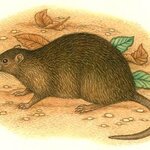Immunology

It took less than a decade for native rats to become extinct on the Indian Ocean's previously uninhabited Christmas Island once Eurasian black rats jumped ship onto the island at the turn of the 20th century.
But this story is more than the typical tale of direct competition: according to new genetic research published in PLoS One, black rats carried a pathogen that exterminated two endemic species, Rattus macleari and R. nativitatis. This study is the first to demonstrate extinction in a mammal because of disease, supporting the hypothesis proposed a decade ago that "hyperdisease conditions…

Don't reach for that antihistamine just yet, if you have allergies. A new article in the December issue of The Quarterly Review of Biology provides evidence that allergies are much more than just an annoying immune malfunction - they may protect against certain types of cancer. So suppressing cancer fighting defenses may not be the best idea.
The article, by researchers Paul Sherman, Erica Holland and Janet Shellman Sherman from Cornell University, suggests that allergy symptoms may protect against cancer by expelling foreign particles, some of which may be carcinogenic or carry…

An international team of researchers at the University of California, San Diego School of Medicine and the University of Basel in Switzerland have issued a report on the mechanism of toxicity of a chemical compound called Dibutyltin (DBT).
DBT is part of a class of high toxic and widely distributed chemical compounds called organotins, DBT is most commonly used as an anti-fouling agent in paint, for example in the fishing and shipbuilding industries. It is also used in the production of polyvinyl chloride (PVC) plastic tubes and bottles.
According to co-lead investigators Michael E. Baker,…

Viruses are nasty opponents, as anyone who has followed the battles against influenza, SARs and HIV/AIDS can attest. They are diverse and in many cases evolve at rates that confound efforts to contain them. Anyone who has gotten a flu shot, and then came down with the flu a few months later because the “strain” of virus that the vaccine was not the same as the “strain” that they were infected with, knows just how fast viruses can evolve. In many cases, medical professional never really know which virus has caused the symptoms in their patients, and this complicates treatment and often leads…

Today, scientists from Procter&Gamble (P&G), the University of Calgary and the University of Virginia announced results from the first study to examine the entire human genome's response to the most common cold virus, human rhinovirus.
The research state (at the genomic level) that the immune system response to the virus, and not the virus by itself, results in common cold symptoms. Data generated by the study will be crucial in the search for new treatments for the common cold, which is the most common illness worldwide, affecting billions of people every year. Specifically, the…

In the UK, the government has chosen the vaccine Cervarix for their human papillomavirus (HPV) vaccination program.
But actual UK doctors choose Gardisal for their own children, says Phil Hammond, general practitioner, writer, and broadcaster, on bmj.com today.
The reason has nothing to do with the effectiveness of either vaccine, but rather with genital warts. "You’d be mad not to protect your daughter against genital warts if you can afford to." he quotes Peter Greenhouse, a sexual health consultant, as saying.
The genital warts lobby is largely undercover, he says…

Amoebas glide toward their prey with the help of a protein switch that controls a molecular compass, biologists at the University of California, San Diego have discovered. Their finding is important because the same molecular switch is shared by humans and other vertebrates to help immune cells locate the sites of infections.
The amoeba Dictyostelium finds bacteria by scent and moves toward its meal by assembling a molecular motor on its leading edge. The active form of a protein called Ras sets off a cascade of signals to start up that motor, but what controlled Ras was unknown…

The discovery of the earliest known cases of human tuberculosis (TB) in bones found submerged off the coast of Israel shows that the disease is 3000 years older than previously thought. Direct examination of this ancient DNA confirms the latest theory that bovine TB evolved later than human TB.
The new research sheds light on how the TB bacterium has evolved over the millennia and increases our understanding of how it may change in the future.
The bones, thought to be of a mother and baby, were excavated from Alit-Yam, a 9000 year-old Pre-Pottery Neolithic village, which has been submerged…

The transportation of antibodies from a mother to her newborn child is vital for the development of that child's nascent immune system.
Those antibodies, donated by transfer across the placenta before birth or via breast milk after birth, help shape a baby's response to foreign pathogens and may influence the later occurrence of autoimmune diseases.
Images from biologists at the California Institute of Technology (Caltech) have revealed for the first time the complicated process by which these antibodies are shuttled from mother's milk, through her baby's gut, and into the bloodstream, and…

Scientists have discovered that a bone infection is caused by a newly described species of bacteria that is related to the tuberculosis pathogen. The discovery may help improve the diagnosis and treatment of similar infections, according to an article published in the International Journal of Systematic and Evolutionary Microbiology.
Some rare genetic diseases can make patients susceptible to infections with Mycobacterium species, the bacteria that amongst other diseases, cause tuberculosis and leprosy. These patients often suffer from recurring mycobacterial infections throughout their whole…